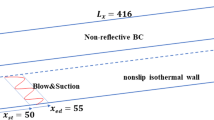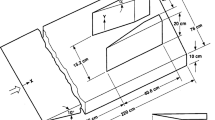Abstract
For hypersonic vehicles, as the temperature in its boundary layer usually exceeds 600 K, for which the molecular vibrational degree of freedom is excited, the perfect gas model is no longer valid. In this paper, the effect of high temperature induced variation of specific heat on the hypersonic turbulent boundary layer of flat plates is investigated by direct numerical simulations with the perfect gas model, i.e. with constant specific heat, as well as with a variable specific heat gas model. The comparison of the results from the two gas models has found that the effect of the variation of specific heat on the velocity of the turbulent boundary layers is relatively small, while its effect on temperature, such as the mean temperature, the temperature fluctuations, is appreciable. It is also found that the mean specific heat is quite close to the specific heat calculated by using the mean temperature, indicating that it is possible to do turbulence modeling. The modeling is done under the variable specific heat gas model with the mean temperature as the variable. The feasibility of such consideration is verified by applying the SST model for variable specific heat turbulence computation.
Similar content being viewed by others
References
Guarini S E, Moser R D, Shariff K, et al. Direct numerical simulation of a supersonic turbulent boundary layer at Mach 2.5. J Fluid Mech, 2000, 414:1–33
Pirozzoli S, Grasso F, Gatski T B. Direct numerical simulation and analysis of a spatially evolving supersonic turbulent boundary layer at M=2.25. Phys Fluids, 2004, 16:530–545
Gatski T B, Erlebacher G. Numerical simulation of a spatially evolving supersonic turbulent boundary layer. NASA Tech. Memo, 2002-211934, 2002
Maeder T, Adams N A, Kleiser L. Direct simulation of turbulent supersonic boundary layers by an extended temporal approach. J Fluid Mech, 2001, 429:187–216
Liu K, Pletcher R H. Compressibility and variable density effects in turbulent boundary layers. J Heat Transfer, 2007, 129:441–448
Duan L, Beekman I, Martin M P. Direct numerical simulation of hypersonic turbulent boundary layers. Part 2. Effect of wall temperature. J Fluid Mech, 2010, 655:419–445
Dong M, Direct numerical simulation of a spatially evolving hypersonic blunt cone turbulent boundary layer at Mach 6 (in Chinese). Acta Aerodyn Sin, 2009, 27:199–205
Dong M, Zhou H. Inflow boundary condition for DNS of turbulent boundary layers on supersonic blunt cones. Appl Math Mech, 2008, 29:985–998
Dong M, Zhou H. The improvement of turbulence modeling for the aerothermal computation of hypersonic turbulent boundary layers. Sci China Phys Mech Astron, 2010, 53:369–379
Malik M R, Anderson E C. Real gas effects on hypersonic boundary-layer stability. Phys Fluids A-Fluid Dyn, 1991, 3:803–821
Jia W, Cao W. The effects of variable specific heat on the stability of hypersonic boundary layer on a flat plate. Appl Math Mech, 2010, 31:979–986
Hornung H. Hypersonic Real-Gas Effects on Transition. In: IUTAM Symposium on One Hundred Years of Boundary Layer Research. Netherlands: Springer, 2006. 335–344
Menter F R. Two-equation eddy viscosity turbulence models for engineering applications. AIAA J, 1994, 32:1598–1605
Tong B G, Kong X Y, Deng G H. Dynamics of Gas Flow. Beijing: Higher Education Press (in Chinese), 1990. 342–345
Huang Z F, Zhou H. Inflow conditions for spatial direct numerical simulation of turbulent boundary layers. Sci China Ser G-Phys Mech Astron, 2008, 51:1106–1115
Li X L, Fu D X, Ma Y W. Direct numerical simulation of a spatially evolving supersonic turbulent boundary layer at Ma=6. Chin Phys Lett, 2006, 23:1519–1522
Author information
Authors and Affiliations
Corresponding author
Additional information
Contributed by Zhou Heng
Rights and permissions
About this article
Cite this article
Dong, M., Zhou, H. The effect of high temperature induced variation of specific heat on the hypersonic turbulent boundary layer and its computation. Sci. China Phys. Mech. Astron. 53, 2103–2112 (2010). https://doi.org/10.1007/s11433-010-4152-5
Received:
Accepted:
Published:
Issue Date:
DOI: https://doi.org/10.1007/s11433-010-4152-5




